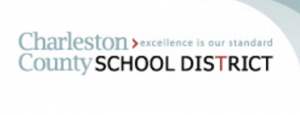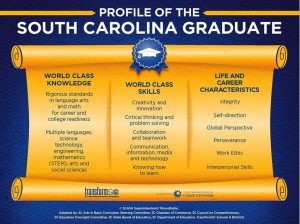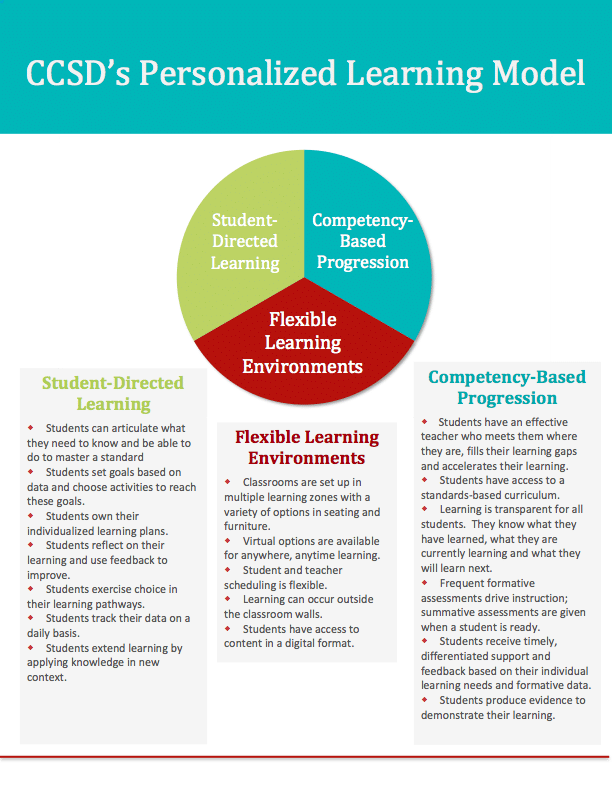Charleston County School District: Breaking Ground for Personalized Learning in Big Districts
CompetencyWorks Blog
 This post kicks off my tour of Charleston County School District in South Carolina. The next post looks more deeply at implementation strategies.
This post kicks off my tour of Charleston County School District in South Carolina. The next post looks more deeply at implementation strategies.
A few times during my visit to Charleston County School District (CCSD), I felt my jaw hit the ground. Even though, at the time, they were just entering into the third year of implementation, the team of district staff, personalized learning coaches, principals, teachers, and partners engaged in this work are advancing our understanding of how we can effectively introduce personalized, competency-based education in medium- to large-sized districts.
In this series—which is based on my two days with Dr. Kristen Brittingham, Director of Personalized Learning; Sherry Kirkland, Personalized Learning Professional Development Administrator; and a team of personalized learning coaches, principals, and teachers—I’ll share some of the most important things I learned, including:
- CCSD’s powerful Personalized Learning Framework
- CCSD’s Personalized Learning Progression
- Strategies for change
- Focus on student agency and achievement
CCSD is making tremendous progress even though they are still in the early stages of implementation. They provide support to approximately twenty of the district’s eighty-six schools. Although they are not yet engaged in whole district implementation, they have been building the supports, tools, and best practices to make this vision a reality. The district is moving to a more personalized approach to professional development via initiatives such as their Read to Succeed District Literacy Plan. It is well worth the visit to Charleston if you are a medium or large (or even small!) district contemplating the move to personalized, competency-based learning. For more information about learning tours please contact Christina_Counts (at) Charleston (dot) k12 (dot) sc (dot) us. (Lake County in Florida and Henry County in Georgia are also districts that can be helpful in thinking through medium-sized district strategies.)
Background
One can’t talk about Charleston without also recognizing the terrible hardship the community has gone through this past year with the massacre at Emanuel African Methodist Episcopal Church, the Walter Scott shooting, and the historic flooding. It is impossible to walk through schools without thinking about how the understanding of the world has changed for both children and adults. However, one thing that has not changed in Charleston is the laser focus to prepare all students to be college and career ready.
CCSD is the second largest school district in the state, representing a unique blend of urban, suburban, and rural schools that span 1,000 square miles. CCSD serves more than 49,000 students, 86 schools, and approximately 3,500 full-time teachers. Forty four percent of students qualify for free/reduced lunch (FRL), and some schools are nearly 100 percent FRL. In regards to racial diversity, 47 percent of the students are white, 40 percent African American, and 9 percent Hispanic.
The district’s journey with personalized learning began in 2011 under the leadership of then Superintendent Dr. Nancy McGinley. District and school leaders began researching best practices in order to build a custom personalized learning model. In July 2015, Dr. Gerrita Postlewait, a leader in the field of personalized learning, was appointed CCSD’s new superintendent. She brings with her a strong focus on building world-class knowledge, skills, and life and career characteristics as outlined in the Profile of the South Carolina Graduate, which includes student agency.

In recent years, CCSD has seen promising improvements in student achievement, including graduation rates. In 2015, the district received its first ever “excellent” rating on its state report card. However, the work does not stop there; the goal is to prepare every child to be successful in college, career, and life. Personalized learning is one way in which CCSD expects to achieve this goal.
CCSD’s Personalized Learning Framework
CCSD spent the last four years researching practices from across the country to develop a system of personalized learning that best meets the specific needs of CCSD’s students and educators. Based on this research and lessons learned from implementation in CCSD classrooms, the district has developed a framework for personalized learning that integrates self-directed learning, competency-based progressions, and flexible learning environments. The pillars of this model are detailed below.

Student-Directed Learning
Students:
- Can articulate what they need to know and do to master a standard
- Set goals based on data and choose activities to reach these goals
- Own their individualized learning plans
- Reflect on their learning and use feedback to improve
- Exercise choice in their learning pathways
- Track their data on a daily basis
- Extend learning by applying knowledge in new contexts
Flexible Learning Environments
- Classrooms are set up in multiple learning zones with a variety of options in seating and furniture
- Virtual options are available for anywhere, anytime learning
- Student and teacher scheduling is flexible
- Learning can occur outside the classroom walls
- Students have access to content in digital format
Competency-Based Progression
- Students have an effective teacher who meets them where they are, fills their learning gaps and accelerates their learning
- Students have access to a standards-based curriculum
- Learning is transparent for all students. They know what they have learned, what they are currently learning and what they will learn next
- Frequent formative assessments drive instruction; summative assessments are given when a student is ready
- Students receive timely, differentiated support and feedback based on their individual learning needs and formative data
- Students produce evidence of learning to determine proficiency
CCSD schools are at different levels of implementation with this framework and move at their own pace, guided by a structured progression of implementation.
Proficiency Scales/Learning Progressions
CCSD has spent the past three years building student proficiency scales or learning progressions in all core content areas in grades K-12. The district also has created literacy and personalized learning proficiency scales for teachers. (Video on Explanation of Proficiency Scales.)
Ensuring that students understand what they need to know and do in order to master standards is essential for students moving toward ownership of their learning. Proficiency scales make learning transparent. CCSD learned how to create proficiency scales with the support of Marzano Research (MR). MR defines proficiency scales as a tool to organize standards into manageable learning progressions. The scales unpack the standard into learning targets on a continuum.
- Level 1 (emerging): Students have little background knowledge and need teacher support;
- Level 2 (developing): Students are building foundational knowledge;
- Level 3 (proficient): the unpacked standard;
- Deeper Learning: real life applications, going beyond the level of rigor of the standard, applying knowledge in new ways, etc.
Rebecca Mestaz, an embedded coach from Marzano Research (MR), describes proficiency scales as “the backbone” of competency-based education. They ensure that students will be assessed with the same yardstick. This progression identifies foundational skills that students need before working on the standard and ensures teachers are teaching the standard at the appropriate rigor level. In CCSD, teachers give a pretest to determine the entry point for learning for each student based on the proficiency scale or progression of learning.
Additional information on proficiency scales is available here.
MR offers a free proficiency scale bank to assist educators.
Key Strategies for Transformation
CCSD has embraced a number of key strategies to improve personalizing learning implementation across schools and to lay the foundation for scalability and sustainability.
1) Comprehensive Framework for Personalized Learning: The district quickly realized that it must clearly define what it meant by personalized learning in order to ensure fidelity and quality of implementation. The Personalized Learning Model and Progression of Implementation are used as a guiding framework. This framework is helpful when aligning district programs and initiatives with personalized learning.
2) Personalized Learning is for Students K-12: When CCSD first began exploring personalized learning, leadership knew that it was important to demonstrate that personalized learning could be successful at elementary, middle, and high school levels. The district strategically identified three high schools and their feeder schools to serve as the early adopters of the personalized learning framework. This strategy ensured that students would have the benefit of a personalized learning education throughout their entire educational career. Furthermore, CCSD has introduced personalized learning in a variety of schools across the socioeconomic spectrum.
3) Personalized Professional Development: Meaningful and individualized professional development has been a component critical to the success of personalized learning in CCSD. This includes ongoing school-wide PD delivered in short modules, ongoing support from personalized learning coaches, and leadership training and personalized coaching for principals. A more detailed post about CCSD’s personalized learning professional development is coming soon.
4) Personalized Implementation for Schools and Classrooms: CCSD acknowledges that schools and teachers have different approaches to personalizing their learning environments. Using the model and progression of implementation detailed above, CCSD has developed a structure that allows schools and teachers to customize their approach while staying true to CCSD’s philosophy of personalized learning.
5) Modeling the Model: In the early stages of implementation, CCSD educators struggled to understand what personalized, competency-based classrooms looked like. To alleviate this problem, the district created multiple demonstration classrooms at the elementary, middle, and high school levels. These demonstration classrooms were “fast tracked” in their implementation so other teachers, principals, and district administrators could see personalized learning at an advanced level. This has been a great success. As teachers have been able to see these practices in action, they have been able to quickly implement and integrate new strategies into their own classrooms. Now all schools in the early adoption group have classrooms that serve as models.
6) Data-Driven Decision Making: CCSD is carefully tracking data in personalized learning schools and classrooms to see which practices are most effective in improving student agency and student achievement. Effective practices are replicated and ineffective practices are analyzed and revised through the continuous improvement process.
7) Strategic Partnerships: CCSD has relied on a number of strategic partners in the development and refinement of its personalized learning framework. A sampling of key partners include Marzano Research, Modern Teacher, Empower Learning, and Apple.
8) Alignment of District Systems: Superintendent Gerrita Postlewait is focused on aligning district systems to better support students and teachers.
9) Embracing a Continuous Improvement Process: Dr. Brittingham credits CCSD’s success to having a growth mindset and the ability to embrace a continuous improvement process. “Every day we are tweaking things to make them better, creating new tools to support principals, teachers, and students, and aligning our work to district initiatives and the state standard for personalized learning. The improvement process is continuing as a result of analyzing what is working and listening to feedback from community members, critical thought partners, district leaders, principals, teachers, parents, and students.”
This video helps explain personalized learning. You can listen to CCSD students talk about personalized learning here.
*A note about digital learning platforms
A digital learning platform that is competency-based is one of the most, if not the most, effective methods of tracking student data and informing instruction. These systems can organize student data (ranging from immediate assessment results to longitudinal data), provide easy access to digital content, serve as a repository for assessments, and, most importantly, allow students to access all of these resources in a way that is personalized to their individual needs. Identifying a digital learning platform to support personalized, competency-based education has proven to be a challenge for many districts, as few learning management systems have been designed to support the competency-based side of the equation. For the CCSD schools personalizing learning, the district is currently piloting Empower Learning (also used by Lindsay Unified School District, Adams 50, Maine Cohort [49 districts], Eastern Carver, Kenowa Hills, Presque Isle, etc.) This system was designed from the ground up to be student centered and support competency-based education.
See also: